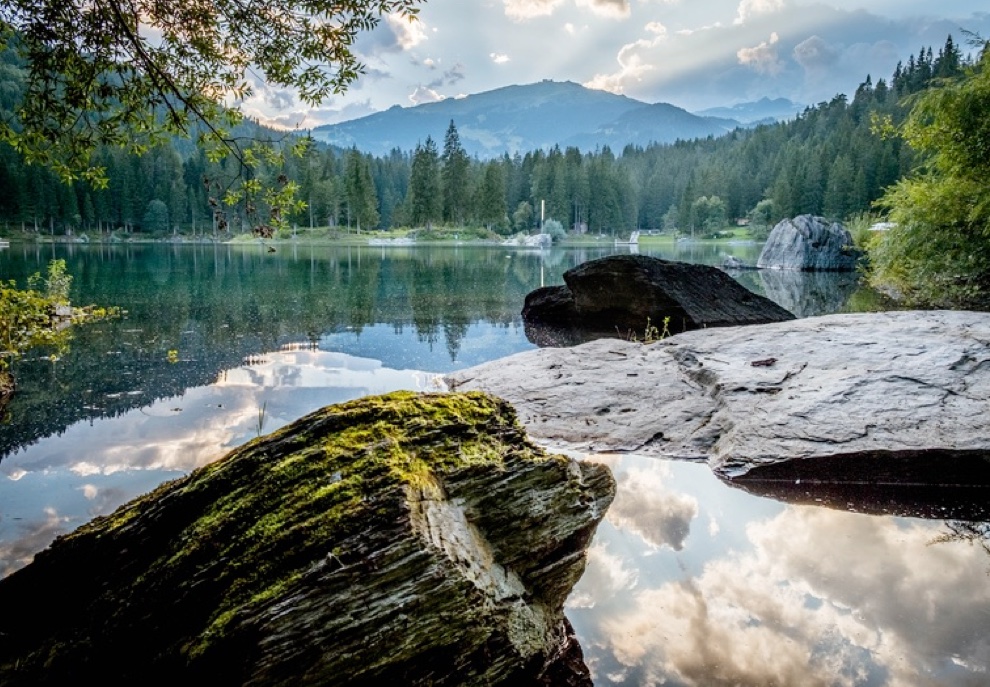Although Graubünden is only the third largest wine canton in the German-speaking part of Switzerland in terms of surface area, the Bündner dominion is the undisputed leader in terms of reputation. No wonder, since Switzerland’s finest Pinot Noir grows here in the Chur Rhine Valley within sight of the Grisons Alps on calcareous slate soils. With a vineyard area of 422 hectares, 2.2 million liters of a wide variety of wines are bottled in Graubünden every year. The most popular wines are Blauburgunder, Müller-Thurgau and Chardonnay.
The history of viticulture in Graubünden
The oldest evidence of viticulture in today’s canton of Graubünden dates back to 765, when Bishop Tello of Chur bequeathed a vineyard near Ilanz to the Disentis monastery in his will. Around 800 the overzealous vine-growers had to be forbidden to work in the vines on Sundays.
As everywhere, the church promoted viticulture; even in the Bündner Oberland and in the Lower Engadine vines grew up to a height of 1200 meters. Until 1600, mainly white wine was cultivated, primarily Elbling. Around 1630 the Blauburgunder is said to have been introduced to the Bündnerland by young mercenaries who had served in Burgundy. Today it is the undisputed main variety and is responsible for the brilliant reputation of the region.
The geography of Graubünden
The canton of Graubünden comprises two cultivation areas, whereby the Italian-speaking Misox, which covers only 30 hectares south of the Alps, is considered a Ticino cultivation area. Most of the Graubünden vines are located in the Chur Rhine Valley, protected by the mountain massifs at their backs. The heart of the so-called Bündner dominion comprises the municipalities of Fläsch, Maienfeld, Jenins and Malans.
Climate and soil in Canton Graubünden
The soils in the Churer Rhine Valley consist mainly of very calcareous Bündner slate, ideal for the ubiquitous Pinot Noir. The microclimate is particularly favorable, as the positive influence of the foehn can hardly be felt as strongly as here in any other region.
Growing areas and vineyards
79 percent of the total of 422 hectares are planted with red varieties, above all with the local matador Blauburgunder, which alone occupies 313 hectares, in the second place is Müller-Thurgau (33 hectares), which is experiencing a certain renaissance, followed by Chardonnay, Pinot Blanc and Pinot Gris. Cultivated only on 3.7 hectares, the old white Bündner rarity Completer, once drunk by the canons of Chur for their evening prayer, the Complet, is still in use. It results in strict wines full of character.
Wines and production in the Churer Rhine Valley
On average, 2.2 million liters of wine are produced. The Bündnerland is famous for its Burgundian-looking Pinot Noir, once more on the fruit, once more developed as a long-lasting, powerful barrique wine. The white wines present themselves very mineral and aromatic; they are often produced without biological acid degradation, but with a fine residual sweetness.

2020
Chardonnay
Gantenbein
- Kanton Graubünden
CHF 305.00
 Sold out
Sold out
2022
Chardonnay
Gantenbein
- Kanton Graubünden
CHF 280.00

2015
Chardonnay
Gantenbein
- Bündner Herrschaft
CHF 385.00

2016
Chardonnay
Gantenbein
- Bündner Herrschaft
CHF 325.00

2017
Chardonnay
Gantenbein
- Kanton Graubünden
CHF 345.00

2019
Chardonnay
Gantenbein
- Kanton Graubünden
CHF 355.00

2020
Gantenbein Riesling
Gantenbein
- Kanton Graubünden
CHF 220.00

2018
Chardonnay
Gantenbein
- Kanton Graubünden
CHF 350.00

2016
Pinot Noir
Gantenbein
- Kanton Graubünden
CHF 225.00

2015
Pinot Noir
Gantenbein
- Kanton Graubünden
CHF 260.00

2017
Pinot Noir
Gantenbein
- Kanton Graubünden
CHF 195.00

2013
Pinot Noir
Gantenbein
- Kanton Graubünden
CHF 282.00

2018
Pinot Noir
Gantenbein
- Kanton Graubünden
CHF 215.00

2019
Pinot Noir
Gantenbein
- Kanton Graubünden
CHF 205.00

2020
Pinot Noir
Gantenbein
- Kanton Graubünden
CHF 210.00

2022
Pinot Noir
Gantenbein
- Kanton Graubünden
CHF 195.00

